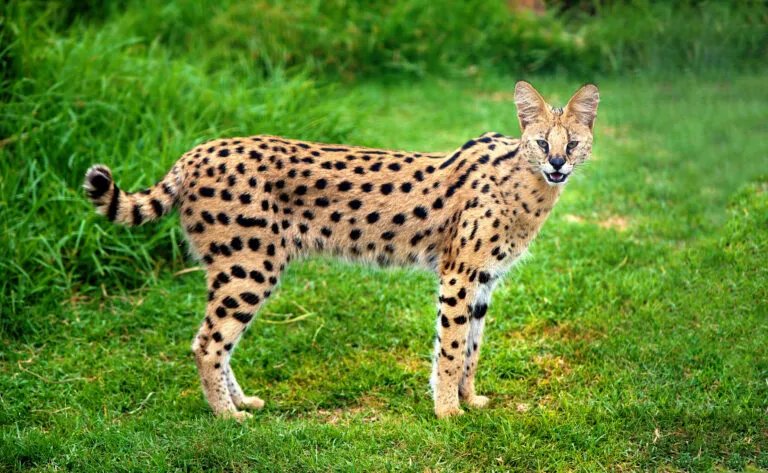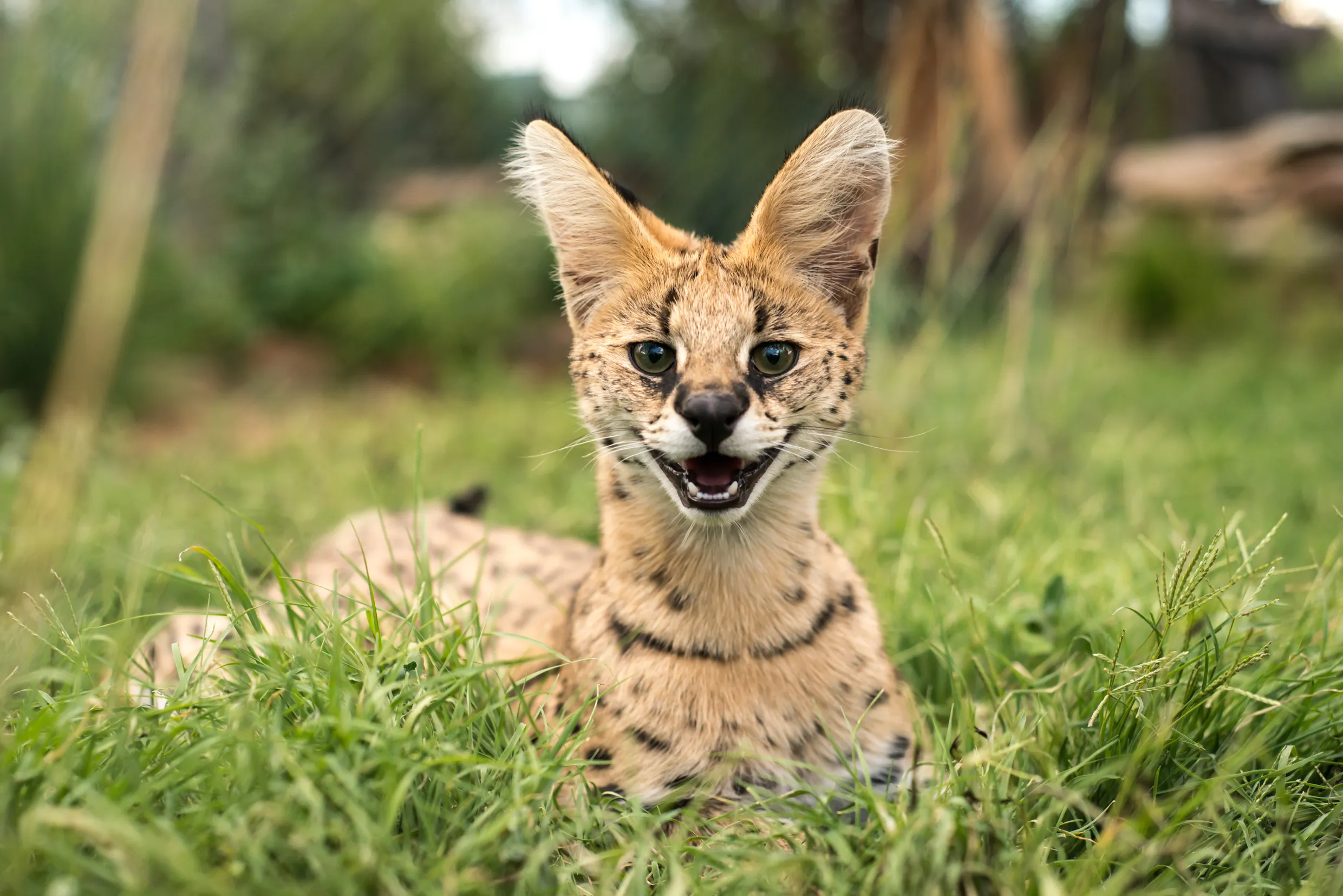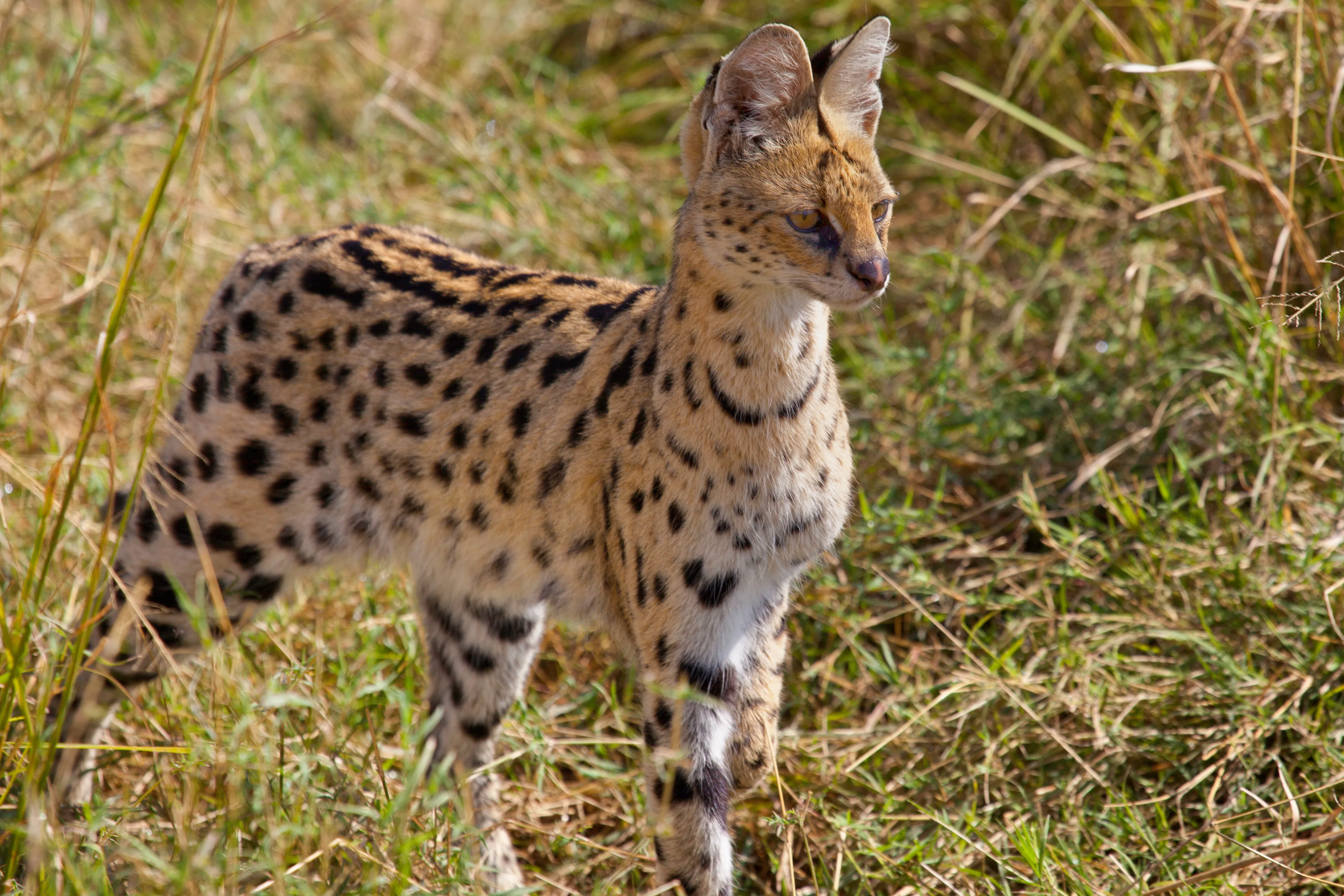Maine Coon
The Maine Coon has now become one of the most popular cat breeds in the world and is enjoying increasing popularity in Ireland, too. This is probably thanks to its authenticity, robustness and excellent character.
Servals aren't domestic cats, but wild cats from the African savannah. In this article however, we would still like to introduce you to this interesting cat. After all, it is the ancestor of the Savannah, a very modern but primal cat breed.

© HBK / stock.adobe.com
Serval in the grass
Servals are not a cat breed, but a distinct species called the Leptailurus serval. Savannah cats, a modern breed named after the homeland of its ancestors, originates from the Serval and emerged at the end of the 1980s from crossing the Siamese with the Serval. It isn’t straightforward for the two species to be able to reproduce. In the animal kingdom, hybrids are often born with impairments. Similarly, not all offspring of cats and Servals are fertile: female offspring can give birth to kittens, but males from the first generations are infertile. The Savannah quickly established itself as a particularly exotic, wild-looking cat breed and is now acknowledged. Unfortunately it has become an object of prestige for some as the descendant of a predator. For breeding, it was necessary to keep Serval cats and domesticate and socialise them with their small feline relatives.
In contrast, the original Serval feels most at ease in its African homeland and can be frequently found in the savannahs south of the Sahara. It lives here as a lone wolf outside of mating season. The population isn’t endangered, but the Serval’s area of population has reduced considerably in the last few decades.
If you catch sight of a Serval, you will immediately recognise that it isn’t a domestic cat. These big cats are more similar to cheetahs or smaller members of the feline family like ocelots. Female Servals weigh between 9 and 12kg, reach a shoulder height of 54 to 62cm and up to a metre in length. Males can reach up to 18kg in weight. In comparison to the rest of its body, the Serval has the longest legs in the feline kingdom. Like other spotted feline predators, the Serval’s fur has a speckled pattern that serves as camouflage. The head is strikingly small, making the Serval’s ears appear bigger. Overall, the whole body exudes the typical strength and grace of a predator, which we recognise from the Serval’s larger relatives too.
 © Fiona / stock.adobe.com
© Fiona / stock.adobe.com
As might be expected, the Serval is wild! So wild that it mostly can’t be domesticated. As a result, a Serval living in captivity will always maintain a certain reserve towards humans. Domesticated Servals can variably become tame. Even if they live from a young age under human care, play and cuddle with their human family, they are still much more wild and primal than a “normal” cat. They always appear alert and are interested in everything around them. If they have been adequately socialised during the kitten phase, Servals often live peacefully amongst each other. However, they are often too aggressive to live with domestic cats and can injure them unintentionally. After all, they are at times three times heavier, for instance if they have play scuffles.
In their African homeland, Servals sneak up to within a few metres of their prey and overpower it with great skill: they can jump both high and wide and even catch birds in flight with their paws. These are their favourite food along with small rodents and hares. Additionally, if they get the opportunity, they’ll pounce on very young antelopes. In captivity, a Serval should be fed fresh meat, therefore an in-depth examination of BARF is necessary. Additionally, many breeders recommend feeding Savannahs, which descend from Servals, with raw meat. However, raw meat alone isn’t enough in the long-term. The feline body needs vitamins and minerals, which is why special dietary supplements should be added too. In short, some expertise is needed to feed a Serval. Healthcare provision should be carried out by a vet with knowledge of wild animals.
When breeding Savannah cats, the different physique is challenging for breeders and can be dangerous for the cats. Although they are able to reproduce, Servals and domestic cats aren’t made for one another: a physically superior Serval male can severely injure a more delicate female when mating. Whilst a “normal” cat is pregnant for around 63 days, a female Serval gives birth to kittens just ten days later. When pairing, kittens can be born premature and often need human intervention to be able to survive. In contrast, if a Serval female gives birth to hybrids after mating with what it considers a small male, there is the danger of it harming the tiny kittens. After all, healthy Serval kittens weigh around 250g at birth and average cats just 90 to 110g. As well, male offspring remain infertile for three generations to come.
 © Guy Bryant / stock.adobe.com
© Guy Bryant / stock.adobe.com
The beauty of these elegant wild animals spark desire among people who wish to share their home with a Serval. However, ownership requirements are extremely high. Even if you meet them, it is still questionable why animals from the African savannah should live in a European corral, since the Serval isn’t suited to being kept in an apartment. The same applies to any direct descendants. Indeed, even the offspring from crossing Servals with domestic cats is subject to approval over several generations in most countries. Also, the ethical issues surrounding keeping a wild cat are considerable.
In the United Kingdom, a license is required to own a Serval. Additionally, for hybrid or cross-bred animals, a license may be required. There are certain legal ownership requirements that may be different in separate countries. Roaming free is forbidden in all places: the danger is too great that the Serval will go rogue and turn feral and out of control.
If you wish to own a Serval or one of its immediate offspring, you have to deal with the authorities first of all. In captivity, Servals can reach the age of 20 like domestic cats, on average more that double the age of their wild relatives.
If you’ve fallen for these exotic cats and can envisage bringing a Savannah home, if not a Serval, you can expect a fully socialised domestic cat subject to no restrictions whatsoever from the fourth or fifth generation onward. Nevertheless, the breed is only suitable for people who wish to own a cat with plenty of fire in its belly and who can cope with its high demands. Although the price of these exotic-looking cats is still in the four-figure range, this is still much less expensive than for animals from the first generation, which are at times only obtainable for the price of a brand-new small car. This is justified: owning wild cat hybrids or even a Serval doesn’t just require financial resources, but a huge amount of expert knowledge too. If you still want an exotic cat but exclusivity isn’t such a crucial factor, you should look into Bengals.
The extent to which generations of offspring resemble the long-legged Servals varies. You should offer as much space as possible if you’re interested in owning this breed: a large apartment or ideally a house with a secured garden. They can be a bit more boisterous and rough-and-ready than other cats when it comes to play, and they like to stay close to their owners. It’s easiest to keep two Savannah cats together so they can keep each other entertained with their wild ways. It’s less recommendable to keep the Savannah together with easy-going cat breeds like British Shorthairs or Persians, although experienced cat owners will recognise exceptions to the rule. You should have experience with cats if giving a home to a Savannah. You should only buy them from breeders who presents its family tree. Breeding wild cat hybrids is very demanding and should be a task for experts alone.
The Maine Coon has now become one of the most popular cat breeds in the world and is enjoying increasing popularity in Ireland, too. This is probably thanks to its authenticity, robustness and excellent character.
Neva Masquerade – a mysterious name for a mysterious thing of beauty! The Neva Masquerade is the point variation on the Siberian cat and shares many characteristics with this breed.